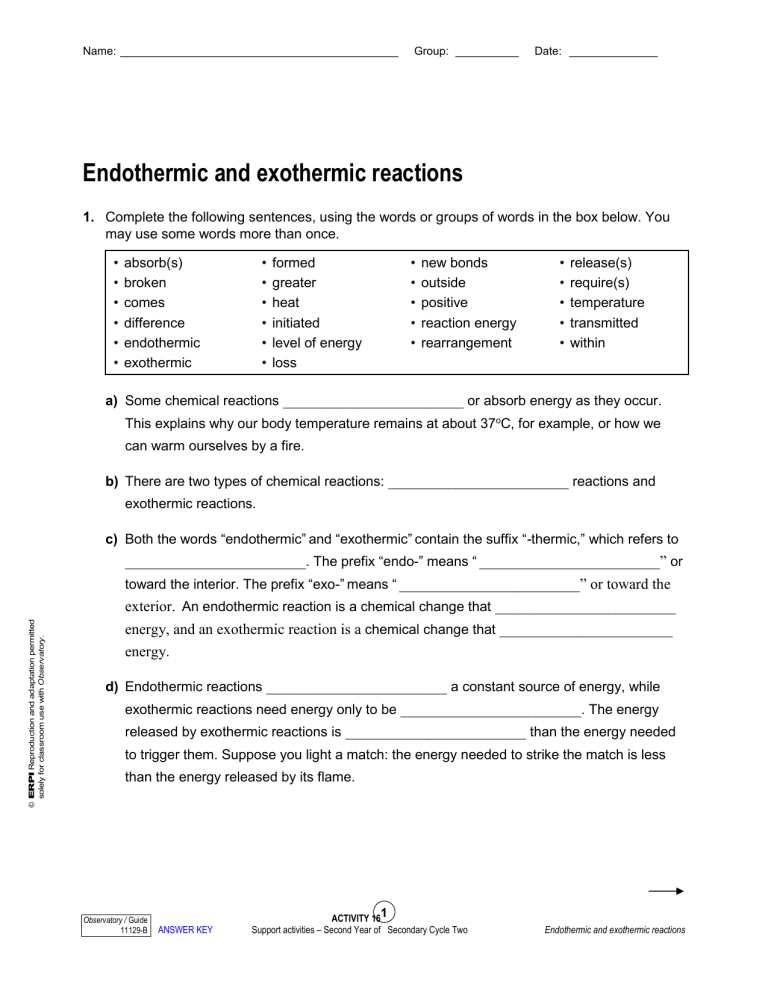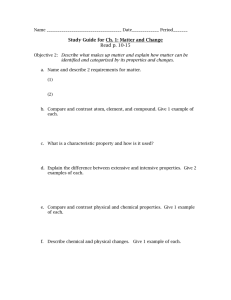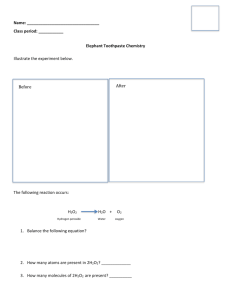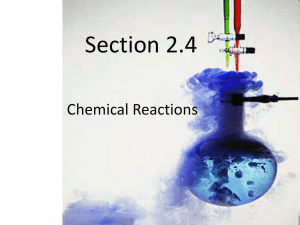
Name: ____________________________________________ Group: __________ Date: ______________ Endothermic and exothermic reactions 1. Complete the following sentences, using the words or groups of words in the box below. You may use some words more than once. • • • • • • • • • • • • absorb(s) broken comes difference endothermic exothermic formed greater heat initiated level of energy loss • • • • • new bonds outside positive reaction energy rearrangement • • • • • release(s) require(s) temperature transmitted within a) Some chemical reactions ________________________ or absorb energy as they occur. This explains why our body temperature remains at about 37oC, for example, or how we can warm ourselves by a fire. b) There are two types of chemical reactions: ________________________ reactions and exothermic reactions. © ERPI Reproduction and adaptation permitted solely for classroom use with Observatory. c) Both the words “endothermic” and “exothermic” contain the suffix “-thermic,” which refers to ________________________. The prefix “endo-” means “ ________________________” or toward the interior. The prefix “exo-” means “ ________________________” or toward the exterior. An endothermic reaction is a chemical change that ________________________ energy, and an exothermic reaction is a chemical change that _______________________ energy. d) Endothermic reactions ________________________ a constant source of energy, while exothermic reactions need energy only to be ________________________. The energy released by exothermic reactions is ________________________ than the energy needed to trigger them. Suppose you light a match: the energy needed to strike the match is less than the energy released by its flame. Observatory / Guide 11129-B ANSWER KEY ACTIVITY 161 Support activities – Second Year of Secondary Cycle Two Endothermic and exothermic reactions Name: ____________________________________________ Group: __________ Date: ______________ e) The heat released by an exothermic reaction is ________________________ to the surrounding environment, while the heat absorbed by an endothermic reaction ________________________ from the surrounding environment. f) To determine whether a reaction is endothermic or exothermic, we can measure the variation in the ________________________ of the environment before and after the reaction. This variation is caused by the ________________________ of atoms during the reaction. In the reactants, bonds are ________________________, and in the products, new bonds are ________________________. To find out the type of reaction involved, we determine the ________________________ between the reactants and the products. It is the ________________________ between the energy absorbed when the bonds of the reactants are broken and the energy released during the formation of ________________________ in products. A ________________________ value indicates that there was a gain in energy, so the reaction was ________________________. A negative value indicates that there was a ________________________ of energy, so the reaction was exothermic. g) The energy absorbed in an endothermic reaction results in a higher ________________________ in the products than in the reactants. In an ________________________ reaction, the level of energy of the products is lower than that of the reactants. 2. Does each of the following situations describe an endothermic or an exothermic reaction? © ERPI Reproduction and adaptation permitted solely for classroom use with Observatory. a) snow melting in the spring b) mist forming on a mirror c) a burning candle d) sublimation of a mothball Observatory / Guide 11129-B ANSWER KEY ACTIVITY 162 Support activities – Second Year of Secondary Cycle Two Endothermic and exothermic reactions





